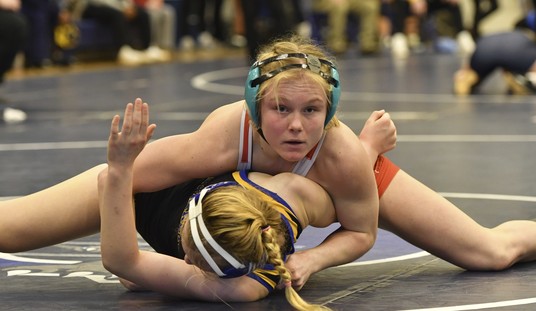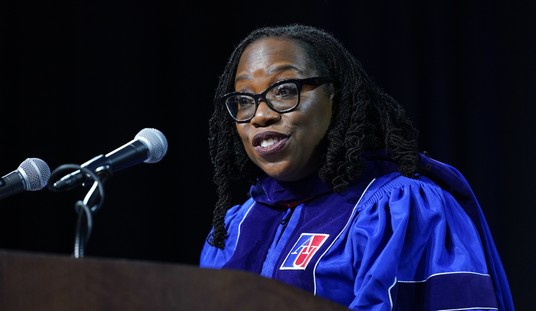Normally, with an issue as complex as immigration, it’s hard to pinpoint any one thing that’s driving a notable shift in opinion. Unless there’s a sudden surge at the border, as there was in the summer of 2014 with children from Central America being sent north via Mexico, there’s no obvious reason for public opinion to change dramatically within a narrow six-month window, as it has here. In fact, if you’d asked me to guess whether support for the wall was up or down lately, I’d guess up for the simple reason that Americans are more worried about terrorism now after major attacks in Paris and Brussels. You don’t want jihadis sneaking in, right? Then build the wall.
But that’s not what we see. On the contrary.

Five years ago the public was evenly divided. Six months ago the public was still evenly divided. Six months later, boom — a disaster at 38/58. What changed? Why isn’t terrorism turning those numbers upside down? Despite how it may seem on cable news, not every development in national politics is driven by Trumpmania, but it’s hard to argue with Harry Enten’s silver-bullet explanation for the shift absent any major developments in immigration patterns:
@allahpundit It could be that Trump has made the issue so his thing that it basically meant if you're against Trump you're against the wall.
— (((Harry Enten))) (@ForecasterEnten) March 31, 2016
Right. This is no longer a national issue, it’s a “Trump issue,” and some voters will let their antipathy to Trump writ large dictate how they feel about particular policies on which he’s taken a strong stance. More data:

Democrats are a mirror image of Trump fans here. There may be some smallish but meaningful contingent of independents or centrist Dems who tentatively favor a wall but are recoiling from it now as part of the process of recoiling from Trump. That’s surprising since you’re not seeing a similar effect on opinions about torture, another issue with which Trump is closely identified. But maybe that’s a function of the relative prominence of the two issues. Immigration is Trump’s bread and butter and a key part of his pitch in the primaries. Torture is more marginal. Either that or Americans’ support for torture is more solid than their support for a wall, such that Trump endorsing both will repel soft support from the latter but not the former. Another mystery: Opinion on a different facet of immigration, i.e. whether to allow illegals to remain in the U.S., hasn’t moved much at all in Pew’s data. Support for letting them stay is at a three-year high of 75 percent, but it stood at 74 percent six months ago and 73 percent back in 2013. If there’s a backlash to Trump driving a backlash to the wall, why isn’t it also driving a backlash against the idea of deporting illegals? (Possible answer: Support for letting illegals stay is already about as high as it can go.)
If you’ve got the time it’s worth flipping through the rest of Pew’s poll, which has fascinating data about the differences between Trump, Cruz, and Kasich supporters on issues like free trade, support for gay marriage, and so son. Although here’s probably the most important difference if you’re looking ahead to November:

On balance, Trump fans think Cruz is more likely to be a good president than a bad one. Meanwhile, there are twice as many Cruz fans who think Trump would be a bad president than a good one. Relatedly:

The 38 percent who expect the party to unite behind Trump as nominee at this point in the primaries is far lower than the number who expected unity behind the last three losing Republican nominees for president. In another data set, Pew asked registered voters generally whether they thought the five remaining presidential candidates would make great, good, fair, poor, or terrible presidents. Cruz pulled 29/36 on great/good versus poor/terrible, with 19 percent saying terrible. Hillary pulled 33/46, with 30 percent saying terrible. Trump: 26/59, with … 44 percent saying terrible. If you believe WaPo’s new poll today, he’s deeply underwater with all sorts of various swing-voter groups (for example, a 33/64 favorable rating among independents) and is even viewed unfavorably by 51 percent of … white men. Worst of all, there’s a statistical case for believing that general election polls start having predictive value beginning in mid-April of an election year, which is rapidly approaching:
The authors found that around 300 days before the election (mid-January), general election polls are essentially meaningless — their predictive value is close to zero. But by the time we get to mid-April of the election year, polls explain about half the variance in the eventual vote split. And mid-April polls have correctly “called” the winner in about two-thirds of the cases since 1952.
Things still change quite a bit afterward, of course, but in that three-month period (which encompasses most or sometimes all of the contested primary voting), we’ve gone from polls telling us basically nothing about what will happen to polls telling us “about half the story” of the election, says Wlezien.
Some casual voters are finally starting to tune into the campaign and rendering their initial verdicts on the candidates. Those verdicts are provisional and can be revisited before November, but as always in life, the first impression tends to stick. On that note, your exit question via Sean Trende: If nominating Trump turns into the sort of wipeout for the GOP that the numbers now suggest, what is U.S. immigration law apt to look like circa 2020?








Join the conversation as a VIP Member